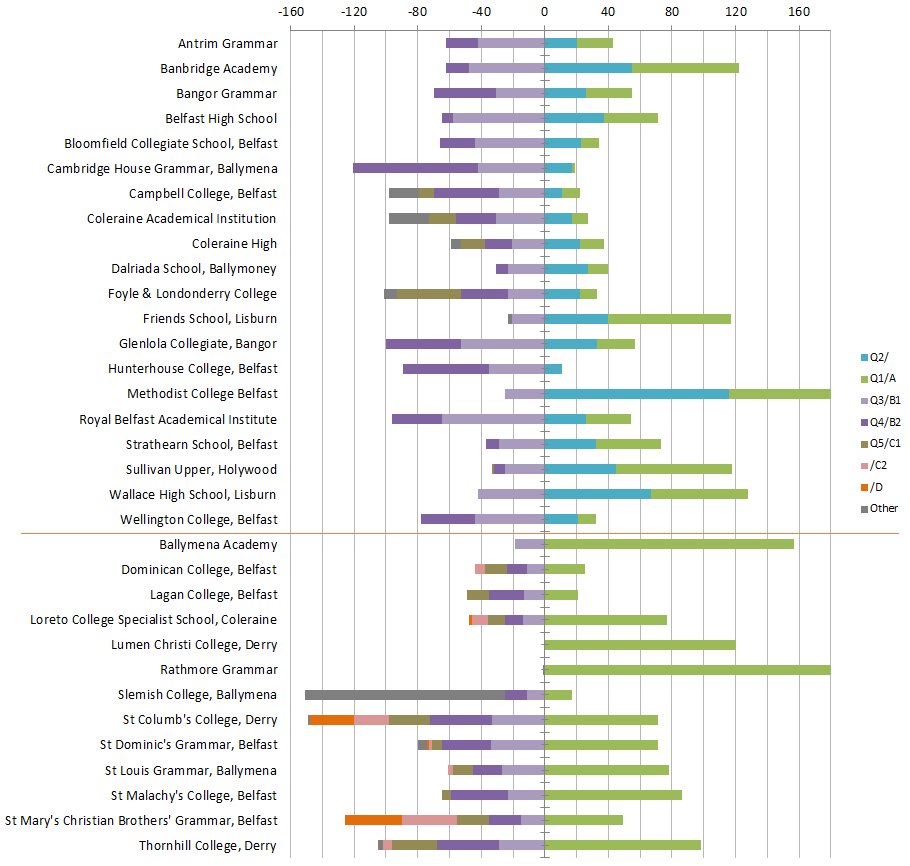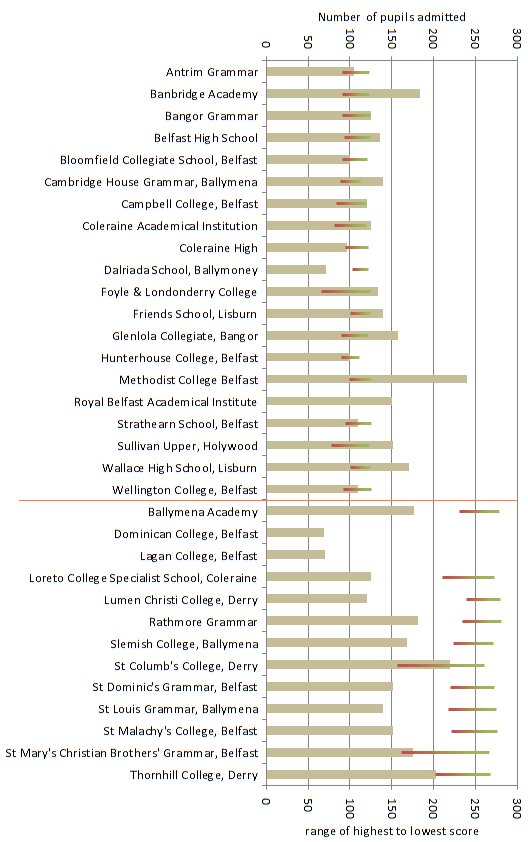Having posted about and charted the recent GCSE results, my thinking turned to that old chestnut of grammar school intake. While some grammar schools manage to fill their First Form
The Belfast Telegraph normally splash with them in mid-October when they have been collated (ie, FOIed). The 2011 figures aren’t yet available, so the charts below use the Belfast Telegraph-compiled figures for the NI grammar school intake in 2010.
I’m just using a subset of the grammar schools, mostly ones in Bangor, Belfast, Coleraine, Derry and Lisburn. The chart below shows the number of pupils taken into Year 8 in September 2010 as well as the range of marks for those pupils. AQE test schools are at the top, and GL Assessment at the bottom. Note that AQE and GL Assessment results aren’t simple marks out of 100, and aren’t directly comparable across the different systems.
Some schools like Dalriada in Ballymoney took in pupils within a tight range of high marks. Others like Foyle & Londonderry College and St Mary’s Christian Brothers’ Grammar in Belfast accept students into Year 8 across a very wide range of marks.
The range of intake is even more obvious when you look at the proportion of each grade that the schools accept. The 2010 AQE results published by the Belfast Telegraph were broken down into five quintiles: Q1–Q5. GL Assessment results were graded A, B1, B2, C1, C2 and D – but each grade doesn’t represent a fixed percentage. Note: (1) comparing AQE and GL Assessments results is a bit like comparing apples and oranges; (2) many schools also accepted a number of pupils without test results, or reserved a proportion of their intake for pupils meeting non-transfer based criteria (these are categorised as ‘Other’ in the chart below).
Given that the normal perception is that grammar schools pick up the most academically able children, I’ve over-simplistically used Quintiles 1 and 2 (AQE) along with Grade A results (GL Assessments) as the ‘top grades’ and shown them on the right hand side of the vertical axis in the chart below, and then mapped the remaining quintiles and grades in descending order on the left hand side.
(Click on the chart to expand it.)
What the chart above shows is that relatively few grammar schools completely filled up with children who achieved the top GL Assessment grade or where in the top two quintiles of the AQE exam. Lumen Christi College and Rathmore Grammar were the two notable exceptions in the areas I sampled, both oversubscribed with pupils achieving the top grade. Schools like Ballymena Academy, Methodist College, Friends School, Sullivan Upper and Wallace High School were close to only accepting in pupils with A grades or in the top two quintiles (ie, the top 40% of AQE entrants).
However, grammar schools like Cambridge House, Campbell College, Coleraine Academical Institute and Hunterhouse College were mostly accepting in students in the bottom three quintiles (ie, lower 60%) of AQE intake.
If the Department of Education’s Every School a Good School policy is truly bedding in and creating educationally rich opportunities right across the range of schools and colleges in Northern Ireland, is it fair that some grammar schools are filling up their classrooms to offer a predominantly academic curriculum to students who could have benefited more from a wider range of academic and vocational learning offered by local secondary schools.
What is it that gives grammar schools their magnetic appeal and kudos? Is their academic promise at least partially illusory? Where’s the system’s desire to build the self esteem of pupils instead of just crudely applying academic pressure? The grammar school lure helps to empty local secondary schools of pupils who they were set up to serve well and help thrive. And in turn that destabilises secondary school funding and creates a downward spiral of results, reputation, and intake.
Yet while secondary schools are disadvantaged by their not-so-elitist-after-all grammar school neighbours, few grammar schools seem to have any problem filling their places and avoiding the application of any kind of minimum entry criteria.
Alan Meban. Tweets as @alaninbelfast. Blogs about cinema and theatre over at Alan in Belfast. A freelancer who writes about, reports from, live-tweets and live-streams civic, academic and political events and conferences. He delivers social media training/coaching; produces podcasts and radio programmes; is a FactCheckNI director; a member of Ofcom’s Advisory Committee for Northern Ireland; and a member of the Corrymeela Community.
Discover more from Slugger O'Toole
Subscribe to get the latest posts to your email.


